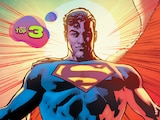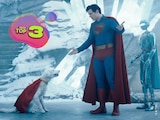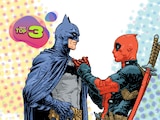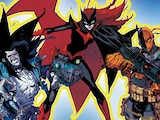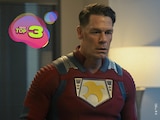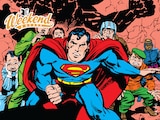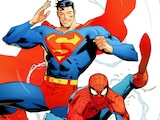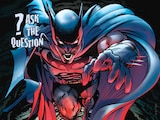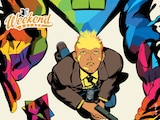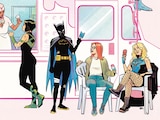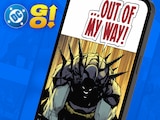Hello! Please do not be alarmed. My name is Alex Jaffe, better known to the DC Community as HubCityQuestion. I’m here today for one reason, and I promise it’s a good one: to answer every single question you have about the DC Universe in all its permutations and mysteries, no matter how granular or obscure. All around the clock, I hear your cases and I do my level best to address each of them. Some are still in progress. Others are answered simply. But the best of the bunch get featured right here, every month. It’s now my pleasure to bring you the cream of this past month’s crop of questions, along with some answers which are hopefully to your satisfaction. Let’s get started.
Shazamily Plan
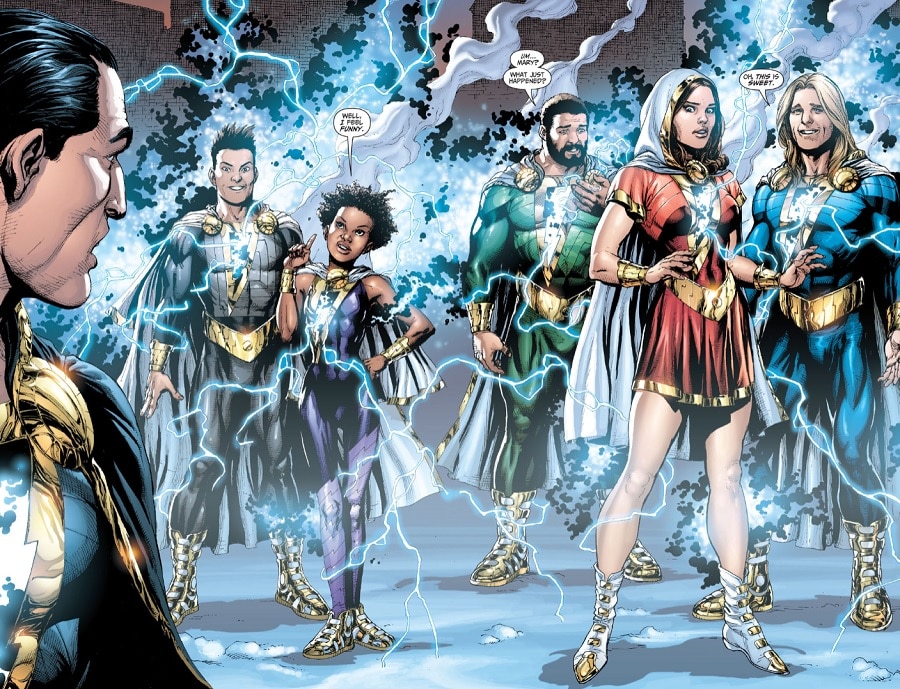
Wrightline1.42741 asks:
The Wizard gave Billy Batson his powers directly from the gods and heroes (or whoever you think they represent), via a mystic staff and power gem. Billy, on the other hand, shared those powers via that same staff and gem with his adopted brothers and sisters to create the Shazamily, thus creating five more versions of himself all equal to each other. Yet, Billy’s powers are not weakened or diminished in any way. How’s that work exactly, Qmeister? And please don’t say "magic."
Well, in Pre-Flashpoint continuity, Jerry Ordway would agree with you. The ‘90s Power of Shazam series is consistent in that when Billy shares his power, it’s divided among whoever’s using it at the time. So, Billy would be at full power if he was solely operating as Shazam, but he’d be at half or a third of his power if Mary or Freddy were also sharing it.
In modern continuity, this might be the case as well, if not for a spell that Billy learns from an entity within the Rock of Eternity identified only as “Francesca.” In 2013’s Justice League #21, Billy learns to draw directly from the patron gods to share his powers, channeling them through him to fuel the powers of those he chooses to include in his “family.”

To that end, it may help to think of each person wielding the Power of Shazam as a conduit. The power, being magic, is infinite. But as a mortal being, a person can only handle so much of it at a time. Billy and his family are all able to operate as equally powerful heroes when empowered—and bear in mind, this is only my working theory, it’s never been explicitly spelled out this way—because each of them are drawing from the same infinite (or arbitrarily large) power source. Think of it as filling six cups instead of one from a spring of power. There’s more than enough to go around.
Moreover, it seems that the power of Shazam is designed that way. It’s not enough for one person to wield it—there are seven chairs in the Rock of Eternity for its guardians. Billy Batson was pulled off the street by the Wizard at the last minute in an act of desperation, but the power he was granted was meant to be enough to be shared.
Amazons Attacked

MatthewHecht asks:
Has Lady Shiva ever battled an Amazon?
A few times. In 2003’s JLA: Welcome to the Working Week, Wonder Woman spars with Shiva, Killer Croc and Cheetah at Belle Reve to sharpen her skills, and Shiva gives her some pointers. In the 2019 Young Justice: Outsiders episode “Elder Wisdom,” Lady Shiva briefly takes out Troia while undercover as a member of the Bwundan Independence Front, assisted by the telepathic Lia Briggs (herself under control of the League of Assassins). When the Outsiders show up as reinforcements, Shiva beats a retreat.
Most recently, in WEBTOON’s Red Hood: Outlaws Episode 31, “End of the Trope,” Shiva has a four-panel sword fight with Artemis, which she loses when Artemis overpowers her by shattering her sword on impact. Only one of these three can be considered canon though, and I’m personally siding with the comic where Shiva schools Wonder Woman.
Teen Titans GO!...to the Comics

Numbuh1Nerd asks:
Teen Titans had so many really cool original characters—how many have we seen make the jump to the page? I seem to remember seeing a wiki page for Control Freak back in the day with a single, stripped-down appearance, but that seems to have vanished…
You’re not imagining things, N1N. Control Freak was originally listed in the solicitation copy for 2019’s Teen Titans Annual #1 to make his comics continuity debut, but was swapped out before publication for an original character named “Joystick”—hence your disappearing wiki page.
That last minute change was mysterious to me, though, so I tracked down issue writer Adam Glass to see if he could comment. Glass enlightened me that when clearing a character from outside of the comics to appear for the first time in print, certain paperwork is required to ensure proper accreditation whenever the character is used going forward. Glass and the editorial staff ultimately didn’t have the time to process the necessary paperwork before the issue, prompting him to work around it with his own creation.
However, other attempts on the same front have been more fruitful. The first—and most successful—animated Teen Titans characters to migrate were the Titans East speedster twins Más y Menos, who appeared in 2006’s Teen Titans #38 as two of the twenty Teen Titans members who temporarily filled out the roster during the missing year between Infinite Crisis and “One Year Later.” They’ve made sporadic appearances in DC comics ever since.

Of all the original H.I.V.E. Academy students, the only one to make the jump so far is the self-duplicating Billy Numerous, who gets his formal introduction in 2008’s Catwoman #78-80.
Heavyweight Titans villain Cinderblock has only made one in-continuity appearance so far, fighting the team in 2009’s Titans #17.
One of the show’s most beloved original characters, Starfire’s pet mutant Silkie, appears throughout the non-canonical Tiny Titans comics beginning in 2009, but Silkie makes a proper canonical debut in 2015’s issue #7 of Starfire’s own solo series.

One of my favorite Teen Titans original animated characters, the Amazing Mumbo, actually does have a one-panel cameo in a major DC comic—2013’s Batman Incorporated #13. Mumbo appears here as one of the global agents of Talia al Ghul’s Leviathan, getting kicked in the face by Batman Inc’s Nightrunner.
Larry, Robin’s less-than-helpful personal interdimensional imp, makes a non-canonical appearance in 2014’s Scooby-Doo Team-Up #6.
Finally, there’s the entire mystery of Red X, which was freshly adapted into the comics as of 2021’s Future State: Teen Titans and played out through the subsequent Teen Titans Academy series. You’ll never guess his true secret identity! (It’s not Jason Todd.)
A Kinder Surprise

Cradle2theGabe asks:
So, you know how in Dark Nights: Metal, Plastic Man is like…an egg? What’s that all about? I know they say something like it’s the only way he can endure the bad vibes from the Dark Multiverse, but when did this happen? What was he doing at the time? Wouldn’t a sphere be a more logical shape?
No specific amount of time is given, but the intended implication is that Plastic Man sat out the New 52 because he had been in this form the whole time, only brought back retroactively into reality thanks to the events of DC Universe: Rebirth. (Um, never mind the fact that we see Eel O’Brian in Forever Evil. Continuity reset.)
In Dark Nights: Metal #5, Mr. Terrific explains that Plastic Man’s elasticity made him a super-conductor for cosmic energy from the Dark Multiverse, an infinite scope of realities generated by our nightmares. Channeling this massive psychic trauma was too much for Plastic Man to bear, so he and Batman kept him in an inert state in the Batcave until they could figure out what was happening to him and how to undo it.
But why an egg? Well, like every concept introduced in Dark Nights: Metal, the metatextual answer is because it was more fun for Greg Capullo to draw. On a symbolic level, an egg suggests incubation, that this long-lost character was on the verge of being birthed into the world. A sphere may be a perfect container, but an egg promises that in the future, it will be unsealed. And narratively, according to Scott Snyder, it’s because that’s the shape Plastic Man chose to condense himself into. He picked the egg. Plastic Man is famously a little wacky.
The Eldest Statesman

AnuTheWorm asks:
Who is the earliest-created character to have appeared after the establishment of the shared universe with the Justice Society? Is it still Dr. Occult (New Fun #6, 1935) or have they dug up somebody even earlier?
For clarity’s sake, I’m asking about characters original to (the-company-that-would-one-day-be-) DC. I know there have been references to a couple pulp novel “proto-superheroes” like the Gladiator and the Shadow apparently existing in the DCU, but that’s not quite what I’m after!
Created by Jerry Siegel and Joe Shuster, Doctor Occult is sometimes cited as DC’s first original character to still be kicking around in a larger capacity in the DC Universe, typically in magic-oriented circles. And that may have been true…until 2016. For the past seven years, the record’s been held by a character who debuted in DC’s New Fun #1, their very first publication: wealthy adventurer Barry O’Neill, one of DC’s very first adventure heroes, created by Lawrence Lariar. Along with his sidekick Legrande, Barry O’Neill largely featured in “yellow peril” stories typical of the era, generally concerned with fighting criminal Asian stereotypes. Over fifty chapters of Barry O’Neill were published between 1935 and 1941 in New Fun, More Fun Comics and Adventure Comics until Adventure Comics #60. In the next issue, he would be replaced by a new feature, one which introduced Ted Knight as Starman.

In 2016’s Batman Annual, Barry O’Neill returned under Steve Orlando’s pen as part of a grand gesture to donate his entire fortune to charity. The billionaire Barry escapes an attack by Minister Blizzard thanks to Batman, only to be murdered later that night by a mysterious villain known as the Stag. Batman would soon pursue the case with the aid of an even older character in Scott Snyder and artist Riley Rossmo’s Batman/The Shadow. And that’s where the record stands, until someone decides to beat it by a few pages by bringing back Jack Woods.
Now aren’t you glad to know that? It just goes to show what you’ll discover when you allow yourself to be curious. I’m always here to assist the wandering mind. All you need to do is ASK… THE QUESTION.
Alex Jaffe is the author of our monthly "Ask the Question" column and writes about TV, movies, comics and superhero history for DC.com. Follow him on Twitter at @AlexJaffe and find him in the DC Community as HubCityQuestion.
NOTE: The views and opinions expressed in this column are solely those of Alex Jaffe and do not necessarily reflect those of DC Entertainment or Warner Bros., nor should they be read as confirmation or denial of future DC plans.

